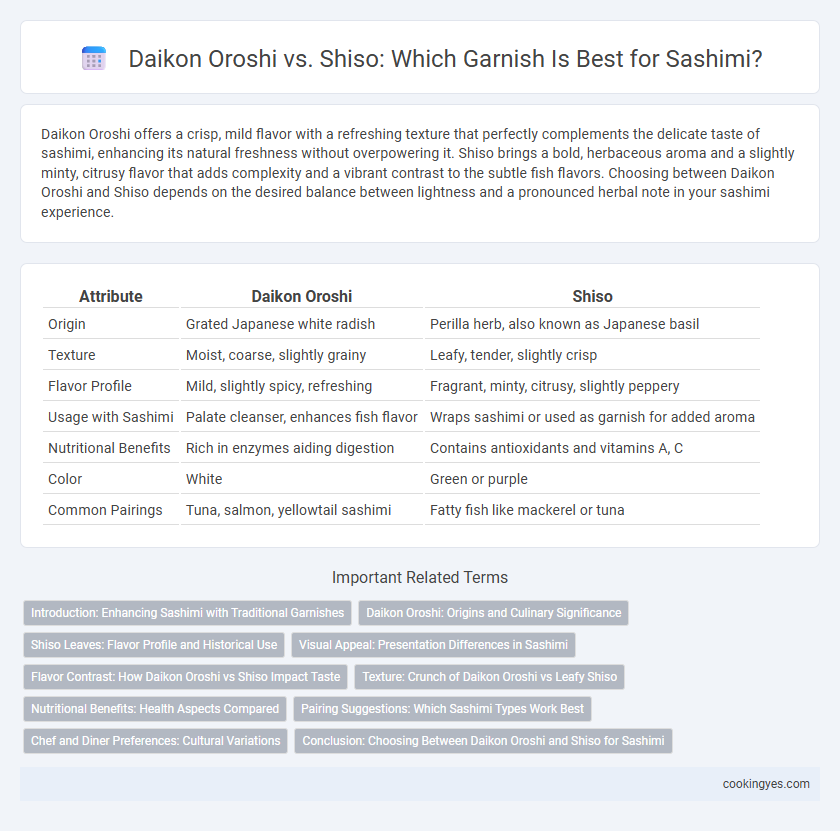Daikon Oroshi offers a crisp, mild flavor with a refreshing texture that perfectly complements the delicate taste of sashimi, enhancing its natural freshness without overpowering it. Shiso brings a bold, herbaceous aroma and a slightly minty, citrusy flavor that adds complexity and a vibrant contrast to the subtle fish flavors. Choosing between Daikon Oroshi and Shiso depends on the desired balance between lightness and a pronounced herbal note in your sashimi experience.
Table of Comparison
| Attribute | Daikon Oroshi | Shiso |
|---|---|---|
| Origin | Grated Japanese white radish | Perilla herb, also known as Japanese basil |
| Texture | Moist, coarse, slightly grainy | Leafy, tender, slightly crisp |
| Flavor Profile | Mild, slightly spicy, refreshing | Fragrant, minty, citrusy, slightly peppery |
| Usage with Sashimi | Palate cleanser, enhances fish flavor | Wraps sashimi or used as garnish for added aroma |
| Nutritional Benefits | Rich in enzymes aiding digestion | Contains antioxidants and vitamins A, C |
| Color | White | Green or purple |
| Common Pairings | Tuna, salmon, yellowtail sashimi | Fatty fish like mackerel or tuna |
Introduction: Enhancing Sashimi with Traditional Garnishes
Daikon Oroshi and Shiso each uniquely elevate sashimi by balancing texture and flavor; Daikon Oroshi provides a refreshing, mild heat and moisture that cleanses the palate, while Shiso offers a vibrant, herbaceous aroma with subtle mint and anise notes. The crisp, watery consistency of grated daikon contrasts seamlessly with the tender, slightly peppery leaves of shiso, enhancing the natural sweetness and umami of fresh sashimi slices. Both garnishes are integral in traditional Japanese cuisine, chosen to complement the delicate taste and presentation of sashimi without overpowering its subtle nuances.
Daikon Oroshi: Origins and Culinary Significance
Daikon oroshi, a grated Japanese radish, is deeply rooted in traditional Japanese cuisine, originating from ancient medicinal practices that valued its digestive properties. Its crisp, mildly spicy flavor and refreshing texture complement sashimi by enhancing the taste of raw fish while aiding digestion. Unlike shiso, which adds a herbal note, daikon oroshi serves as a palate cleanser and an essential garnish that balances the richness of sashimi.
Shiso Leaves: Flavor Profile and Historical Use
Shiso leaves offer a unique blend of citrusy, minty, and slightly spicy flavors that enhance the delicate taste of sashimi while providing a refreshing contrast to the richness of raw fish. Historically, shiso has been used in Japanese cuisine for centuries not only for its aromatic qualities but also for its antimicrobial properties, making it an ideal accompaniment to raw seafood. Its vibrant green or purple leaves serve both a decorative and functional role, elevating the sashimi experience beyond mere presentation.
Visual Appeal: Presentation Differences in Sashimi
Daikon Oroshi adds a delicate, snowy white contrast beneath sashimi slices, enhancing the dish's clean and minimalistic aesthetic. Shiso leaves provide vibrant green hues and a textured backdrop, creating a striking visual contrast that highlights the sashimi's rich colors. These presentation differences influence the overall sensory experience, with Daikon Oroshi emphasizing purity and freshness, while Shiso introduces a bold, natural vibrancy.
Flavor Contrast: How Daikon Oroshi vs Shiso Impact Taste
Daikon oroshi offers a mild, refreshing crunch with subtle sweetness and a slight peppery bite, which balances the delicate flavors of sashimi without overpowering them. Shiso introduces a bold, aromatic complexity with hints of mint, basil, and anise, enhancing the sashimi's taste with vibrant herbal notes and a touch of zest. The choice between daikon oroshi and shiso greatly influences the flavor profile, either complementing sashimi with gentle freshness or intensifying it through distinct, layered herbal flavors.
Texture: Crunch of Daikon Oroshi vs Leafy Shiso
Daikon oroshi provides a refreshing, crisp crunch that contrasts beautifully with the tender, leafy texture of shiso, enhancing the overall mouthfeel of sashimi. The finely grated daikon adds a mild spiciness and moist crunch that balances the delicate, aromatic softness of shiso leaves. This textural interplay elevates the sensory experience, making each bite of sashimi more dynamic and enjoyable.
Nutritional Benefits: Health Aspects Compared
Daikon Oroshi, grated radish rich in enzymes like amylase and antioxidants such as vitamin C, aids digestion and supports immune health when served with sashimi. Shiso leaves provide unique nutritional benefits including anti-inflammatory compounds, omega-3 fatty acids, and high levels of vitamins A and K, contributing to cardiovascular and bone health. Both toppings offer distinct health advantages that complement the raw fish's nutritional profile, enhancing overall nutrient absorption and metabolic function.
Pairing Suggestions: Which Sashimi Types Work Best
Daikon Oroshi pairs exceptionally well with rich and fatty sashimi such as salmon and toro, as its sharp, refreshing flavor cuts through the fattiness, enhancing the overall taste experience. Shiso complements lighter sashimi like yellowtail and sea bream, offering a fragrant, herbal note that elevates the delicate flavors without overpowering them. Combining these garnishes thoughtfully can create a balanced sashimi platter that highlights the unique textures and flavors of each fish.
Chef and Diner Preferences: Cultural Variations
Daikon Oroshi and Shiso both serve as traditional accompaniments to sashimi, reflecting distinct cultural preferences embraced by chefs and diners across Japan. Chefs favor daikon oroshi for its mild, refreshing texture that enhances the delicate flavors of sashimi without overpowering, while shiso is chosen for its aromatic, slightly spicy notes that add complexity and a vibrant visual appeal. Regional variations influence diner preferences, with northern Japan leaning towards daikon oroshi's cleansing properties and southern regions appreciating shiso's herbaceous qualities, highlighting the interplay of local tastes and culinary artistry.
Conclusion: Choosing Between Daikon Oroshi and Shiso for Sashimi
Daikon oroshi enhances sashimi with its crisp texture and mild, slightly spicy flavor, complementing delicate fish without overpowering it. Shiso offers a vibrant, aromatic herbaceous note that adds complexity and a refreshing contrast to rich sashimi varieties. Selecting between daikon oroshi and shiso depends on whether a subtle palate cleanser or a bold, fragrant accent is desired to elevate the sashimi experience.
Daikon Oroshi vs Shiso for Sashimi Infographic

 cookingyes.com
cookingyes.com